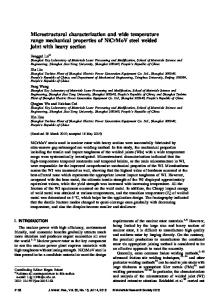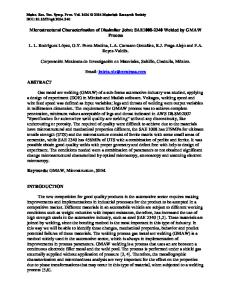Microstructural and Mechanical Characterization of a TRIP-800 Steel Welded By Laser-CO 2 Process
- PDF / 541,900 Bytes
- 6 Pages / 612.12 x 792.12 pts Page_size
- 16 Downloads / 367 Views
Microstructural and Mechanical Characterization of a TRIP-800 Steel Welded By LaserCO2 Process G.Y. Perez-Medina1, P. Zambrano2, H.F. López 1, F.A. Reyes-Valdés1, V. H. López-Cortés1, 1 Corporación Mexicana de Investigación en Materiales. Calle Ciencia y Tecnología #790, Fracc. Saltillo 400, Saltillo, Coah. México 25290. 2
Universidad Autónoma de Nuevo León. Facultad de Ingeniería Mecánica y Eléctrica. Av. Pedro de Alba S/N. Col Ciudad Universitaria. San Nicolás de los Garza Nuevo León. ABSTRACT This paper presents results on the impact of Laser CO2 process variables on the weldability, phase transformations and tensile properties of a TRIP800 Steel. The microstructure of this steel is comprised of ferrite, bainite and retained austenite phases. This is obtained by controlled cooling from the intercritical annealing temperature to the isothermal bainitic holding temperature. These steels have been increasingly used in the last 10 years in the automotive industry and for these materials to be used effectively; the influence of material and the CO2 laser welding process condition must be clearly understood. Hence, in this work the effect of the welding process on the resultant microstructures and on the exhibited mechanical properties is investigated. It is found that the tensile strength of welded specimens falls below 800 MPa and that the elongation becomes 15 % or lower. In turn, this clearly indicates that the implemented laser welding process leads to a reduction in the TRIP800 steel toughness. KEYWORDS: AHSS, TRIP Steel, GMAW, Laser, welding INTRODUCTION The demand for high efficiency vehicles has lead to the development of advanced steels with unique mechanical properties. Among these steels, the advanced high strength steels (AHSS) have been developed for the manufacture of low weight car bodies using thin sheet gauge of less than 1 mm [1]. The AHSS for applications in the automotive sector include transformation induced plasticity (TRIP) steels [1]. TRIP steels possess a microstructure consisting of a ferrite (F) and bainite (B), including retained austenite (RA) phases. The enhanced plastic behavior of TRIP steels is attributed to the strain induced transformation of the retained austenite into martensite during deformation. These steels exhibit relatively high work hardening rates and remarkable formability. In addition, the level of applied plastic strain needed to induce the austenite to martensite transformation is strongly dependent on the carbon content. At low carbon levels, the retained austenite transforms almost immediately once the material reaches the yield strength. At elevated carbon contents, the retained austenite becomes increasingly stable and can only transform at elevated levels of plastic straining such as the ones found during a sudden crash event [2]. The formation of unwanted martensite is among the main concerns related to welding [3, 4]. It has been found that in low heat input welding processes such as resistance spot welding (RSW), high carbon martensites can form in the weld tha
Data Loading...











